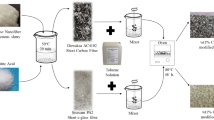Abstract
Composites of graphite nanoplatelets (GNPs) and rubbery epoxy (RE) resins as adhesives and pads are evaluated as thermal interface materials (TIM). GNP-15 and GNP-5 (15 and 5 µm across, respectively) were loaded in RE by 3-roll milling to produce GNP/RE composites. The role of composite processing techniques on the texture, thermal and electrical conductivities and compression properties of composites was studied and compared. Scanning electron microscopy revealed uniform dispersion of GNPs in RE, regardless of loading and X-ray diffraction texture measurement showed less platelet alignment in the composites at low loadings. Thermal conductivities of 20 wt% GNP-15/RE (3.29 W/m K) and 35 wt% GNP-5/RE composite (2.36 W/m K) were both significantly higher than pure RE (0.17 W/m K). GNP/RE retained good compliance, compressive moduli at 20 wt% loading being comparable to commercial BN/silicone TIM. Although thermal contact resistance of GNP/RE was higher than for commercial paste, its interfacial thermal transport outperformed GNP/silicone (due to RE’s strongly adhesive nature) and, across thick bond lines, outperformed reported GNP-pastes. The 20 wt% GNP-15/RE thermal pad had significantly lower thermal contact resistance than other GNP/RE pads. This decreased with increasing applied pressure, being comparable to commercial BN/silicone pad. GNP/RE composites are thus promising candidates for thermal interface adhesives and pads.












Similar content being viewed by others
References
D.D.L. Chung, J. Mater. Eng. Perform. 10, 56–59 (2001)
J.P. Gwinn, R.L. Webb, Microelectron. J. 34, 215–222 (2003)
R. Linderman, T. Brunschwiler, B. Smith et al., in THERMINIC 2007, 2007
F. Sarvar, D.C. Whalley, P.P. Conway, IEEE 2006 Electronics Systemintegration Technology Conference, Dresden, 2006, pp. 1292–1302
K.C. Otiaba, N.N. Ekere, R.S. Bhatti et al., Microelectron. Reliab. 51, 2031–2043 (2011)
C. Lin, D.D.L. Chung, Carbon 47, 295–305 (2009)
J. Liu, T. Wang, B. Carlberg et al., in Electronics System-Integration Technology Conference, 2008 vol. 2, pp. 351–358
C.-K. Leong, Y. Aoyagi, D.D.L. Chung, Carbon 44, 435–440 (2006)
A.A. Balandin, S. Ghosh, W. Bao et al., Nano Lett. 8(3), 902–907 (2008)
M.H. Al-Saleh, U. Sundararaj, Carbon 47(1), 2–22 (2009)
A. Yu, P. Ramesh, M.E. Itkis et al., J. Phys. Chem. C 111, 7565–7569 (2007)
D. Fabris, M. Rosshirt, C. Cardenas et al., J. Electron. Packag. 133(2), 020902 (2011)
Z. Lingbo, D.W. Hess, P. Wong, in Proceedings 57th Electronic Components and Technology Conference, 2007 (ECTC ’07), 2007, pp. 2006–2010
K.M.F. Shahil, A.A. Balandin, Solid State Commun. 152(15), 1331–1340 (2012)
B. Li, W.-H. Zhong, J. Mater. Sci. 46, 5595–5614 (2011)
Q. Mu, S. Feng, Thermochim. Acta 462, 70–75 (2007)
M.A. Raza, A.V.K. Westwood, C. Stirling, Mater. Chem. Phys. 132(1), 63–73 (2012)
M.A. Raza, A. Westwood, C. Stirling, Carbon 50(1), 84–97 (2012)
M.A. Raza, A.V.K. Westwood, A.P. Brown et al., Compos. Sci. Technol. 72(3), 467–475 (2012)
M.A. Raza, A. Westwood, A. Brown et al., Carbon 49(13), 4269–4279 (2011)
M. Raza, A. Westwood, A. Brown et al., J. Mater. Sci.: Mater. Electron. 23, 1–9 (2012)
M.A. Raza, A. Westwood, C. Stirling, Mater. Design 85, 67–75 (2015)
S. Ganguli, A.K. Roy, D.P. Anderson, Carbon 46, 806–817 (2008)
B. Debelak, K. Lafdi, Carbon 45, 1727–1734 (2007)
Acknowledgements
The authors would like to thank EPSRC, UK, Morgan Advanced Materials, UK and Higher Education Commission of Pakistan (Grant No. 20-3283) for providing financial support for carrying out this research work.
Author information
Authors and Affiliations
Corresponding author
Rights and permissions
About this article
Cite this article
Raza, M.A., Westwood, A. & Stirling, C. Graphite nanoplatelet/rubbery epoxy composites as adhesives and pads for thermal interface applications. J Mater Sci: Mater Electron 29, 8822–8837 (2018). https://doi.org/10.1007/s10854-018-8900-z
Received:
Accepted:
Published:
Issue Date:
DOI: https://doi.org/10.1007/s10854-018-8900-z




